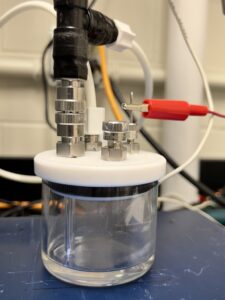Researchers, from left, Matthew Confer, Scott Dubowsky, and Jian Wang combined their expertise in chemistry and plasma engineering to demonstrate a metal-catalyst-free approach to form carbon-carbon bonds.
An Illinois interdisciplinary research team develops electrically powered, metal-free approach as a sustainable way to form carbon-carbon bonds used in production of pharmaceuticals and plastics

The plasma-driven organic reaction process, which only requires electricity, produces electrons from argon gas and then injects these electrons into solution (pictured above and in the closeup photo below) to generate solvated electrons.
Through an interdisciplinary collaboration, Illinois researchers in Nuclear, Plasma, and Radiological Engineering, Bioengineering and Chemistry combined their expertise to develop this novel metal-catalyst-free approach that could lead organic chemistry in a new direction, according to the researchers.
In a study published in the Journal of the American Chemical Society, the team explains how they used electricity and a plasma-liquid process to generate solvated electrons to form carbon-carbon bonds in a pinacol coupling reaction. C-C bond formation is widely used in the production of many man-made chemicals like pharmaceuticals and plastics.
According to researchers, this is the first example of plasma-generated solvated electrons for an organic redox coupling reaction and offers a sustainable solution for similar reductive organic reactions. Typically, such reactions require metal reagents or catalysts that are not only scarce and costly, but also present safety or environmental issues and sometimes require heat in the reactive process.
“Our process only really requires electricity — other than the reactor cell and equipment — and in the future hopefully this can come from renewable sources like wind or solar or nuclear, so the whole process is sustainable,” said study co-author R. Mohan Sankaran, Donald Biggar Willett Professor in Engineering in the Department of Nuclear, Plasma, and Radiological Engineering.
Sankaran said their process produces electrons from argon gas and then injects these electrons into solution to generate solvated electrons, a powerful chemical species typically generated by radiolysis, which requires complex equipment.
“In our case, the solvated electrons are generated with just a DC power supply and a relatively simple electrolysis reactor that houses our electrodes and the solution where we have the organic substrates,” said Sankaran, whose group has been developing atmospheric pressure plasmas for over a decade, and in previous work, has applied this type of plasma-liquid process to other applications – nanoparticle synthesis and nitrogen fixation. “We were curious about organic chemistry, but we had no expertise in either the methods or the characterization.”
Sankaran, who reached out to Jeffrey S. Moore, research professor in chemistry, for expertise, said this project would not have been possible without collaboration.
“Most of this is chemistry — something that my group doesn’t do — and there is no way we would have succeeded without having someone with the requisite chemistry background,” Sankaran said.
Jian Wang, lead author of the study and a postdoctoral associate in the Moore group, brought his expertise in chemistry and materials science to the project and worked with plasma expert Scott Dubowsky, study co-author and research scientist in the Sankaran group, to learn the plasma-liquid process and then identify an organic reaction to study.
Wang experimented with different organic substrates, characterizing reactions using various analytical techniques, and ultimately chose pinacol coupling, because it is a well-established reaction for carbon-carbon bond formation and a reaction they believed could work with the plasma liquid process.
Matthew Confer, another co-author and a postdoctoral researcher in the group of Cancer Center at Illinois Director Rohit Bhargava, professor of bioengineering and faculty affiliate in chemistry, used his computational chemistry expertise to model how the pinacol product was formed from the solvated electron chemistry and radical reactions.
“This is an excellent illustration of the golden rule for a successful collaboration: the best collaborators share a common goal but bring different expertise,” said Moore, Stanley O. Ikenberry Research Professor, Professor Emeritus of Chemistry, and Howard Hughes Medical Institute Professor.
There have been a few studies where a plasma was used for an organic reaction, Sankaran explained, but the reactions and the mechanism were different.
“The plasma was typically used to oxidize a chemical and the chemical that was produced by the plasma was a reactive oxygen species. In our case, the reaction we studied was reduction which required electrons (or solvated electrons), and the reduction led to the formation of new carbon-carbon bonds,” Sankaran said.
Their next step will be applying their process to another organic chemistry reaction and showing that this approach is general and can be applied to different reactions.
“We also hope to find a reaction that is difficult to carry out, because it has a low yield, requires harsh conditions, or there is no active metal,” said Sankaran, who also explained that they hope to address one issue their study revealed — that yields can be limited by mass transfer limitations. “Our reaction occurs at the interface of a plasma and the solution, and for the substrate to reach the interface, it must diffuse. We can address this issue by incorporating liquid flow which will enhance mass transport by convection. Liquid flow will also potentially help us scale up the process whereby we can make a product continuously.”
Wang said one particular challenge for plasma electrochemistry as an alternative to more traditional organic synthesis is that the plasma is so energetic.
“Although we are able to achieve relatively good yield and selectivity, the control is still not as good as for example traditional chemistries with metal catalysts, or electro- or photocatalytic chemistries,” Wang said. “We are working on improving the controllability and selectivity right now.”
The study, “Plasma Electrochemistry for Carbon−Carbon Bond Formation via Pinacol Coupling,” is available online. DOI: 10.1021/jacs/3c01779
Editor’s note:
- To reach R. Mohan Sankaran, email rmohan@illinois.edu
- To reach Jeffrey Moore, email jsmoore@illinois.edu
- To reach Rohit Bhargava, email rxb@illinois.edu
The original story by the Department of Chemistry is available here.

